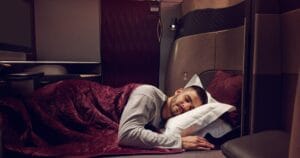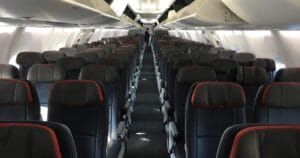Most airlines offer different seat classes on their airplanes. There are 4 classes, sometimes called different seat cabins. Each class is a completely separate section on the plane, where the experience is completely distinct. It’s not well known; many think that first class and business class are the same thing.
In fact, most travelers think that economy class is their only option. But thanks to the wonderful world of travel rewards, it’s so easy to travel in luxury and to book business class for less than economy class as we do ourselves.
So we wanted to share the basics of seat classes. Seat classes should not be confused with fare classes, which are also very important to understand.
Here’s what you need to know about airplane seat classes (sometimes also called travel classes).
Basics — Airplane seat classes
Pretty much all travelers know economy class, but it’s the other 3 that are much less known. Collectively, the other 3 classes are called premium cabins or premium seat classes.
Here are the 4 airplane seat classes that exist:
- Economy class
- Premium economy class
- Business class
- First class
Even among the fairly experienced travelers, many don’t know that some planes have both business class AND first class. And less experienced ones almost always use both terms interchangeably.
It’s normal not to know. It’s another of the many examples that there’s always more to learn to become a travel pro: sign up for Flytrippers’ free newsletter so you too can become a pro!
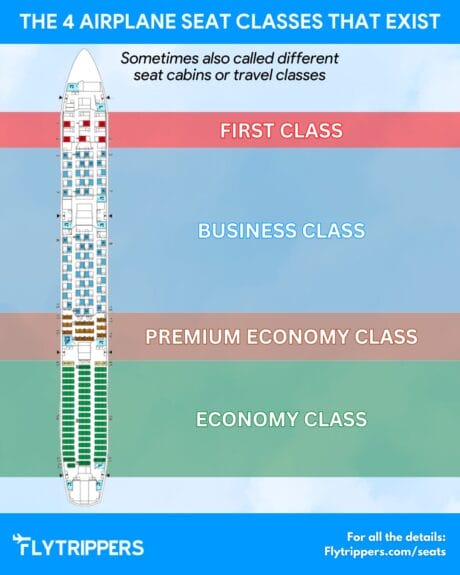
Here are the basics of the 4 airplane seat classes:
- Economy class
- Basic seats you surely know
- Premium economy class
- Slightly better seats
- In a separate section (not within economy)
- Additional services sometimes offered
- Business class
- Lie-flat pod seats for the “real” one
- Seats similar to premium economy sometimes
- Many additional services offered
- First class
- Even better than business class
- Or just another name for business class sometimes
- Many additional services offered
It looks a bit more complex for the last 2, but it’s really not that bad. I’ll come back to this in the next section.
Economy class is obviously the best for traveling for less if you pay with money, but also with points if you want to travel more often! If you don’t necessarily want to travel more often, it’s extremely easy to travel in premium cabins for less money than economy class, thanks to airline points!
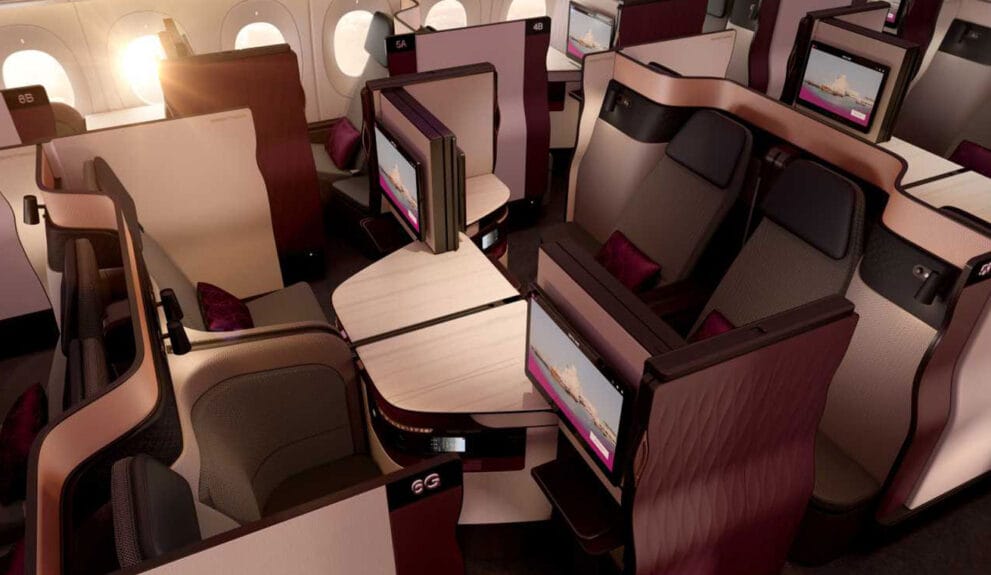
Usual layouts — Airplane seat classes
Airplane layouts vary. Which ones of the 4 seat classes you’ll find onboard changes from one airline to another, of course, but also from one aircraft to another on the same airline.
Here is the usual layout of seat classes:
- Most narrowbody aircraft have just 2 classes
- Economy class is almost always present
- Only one premium cabin is present, often
- The premium cabin varies (that’s the only complexity)
- Most widebody aircraft have just 3 classes
- First class is extremely rare
- Only a few airlines have all 4 classes
- Only a few of their aircraft have all 4
This is really the only exception: sometimes, airlines use the terms business class and first class for classes that are inferior to “real” business and first classes. Especially on narrowbody aircraft (which usually operate shorter flights). Sometimes “real” business class is referred to as “international business class.”
For example, business class on domestic U.S. flights is called first class, but these aren’t lie-flat pod seats like “real” business class. In Europe, business class on short-distance flights simply has blocked middle seats. In short, the name can be misleading: you need to verify.
Differences and variations — Airplane seat classes
Not all business classes are equal. Not at all. It varies enormously!!! Same thing for all seat classes. This is probably THE most vital thing to understand about premium cabins.
Here are some very important concepts about seat classes:
- Airlines often give them a unique name
- It’s irrelevant; these 4 classes are still what exist
- Their names are just marketing and branding
- The quality of a class varies enormously from one airline to another
- Some business classes are much better
- Just like some economy classes are better
- The quality of a class varies within the same airline
- Often between narrowbody and widebody aircraft
- But it can also be very different from one model to another
For example, Air Canada has Signature Class and Qatar Airways has the Qsuite. These are business classes in both cases. Both are very good, but Air India’s business class is something you wouldn’t wish on an enemy. I’m exaggerating a bit… but you get the principle: it varies.
Air Canada’s business class on smaller aircraft is completely different, and inferior. As for Qatar Airways, most Boeing 777s have Qsuites, while Boeing 787s have an inferior business class (even though they’re all widebody aircraft). In short: it varies.
Features — Airplane seat classes
I’ll go through each airplane seat class separately below, but here’s an overview of the features that vary from one airline or aircraft to another for the hard product, the soft product, and the airport experience. The hard product is what is fixed and can’t change from flight to flight, while the soft product is the rest.
Here are the main elements that can vary:
- Hard product onboard
- Seat width
- Legroom
- Entertainment system
- Seat recline
- Seat features
- Storage space
- Soft product onboard
- Food
- Beverages (alcohol can be banned)
- Service
- Amenity kit
- Bedding
- At the airport
- Boarding order
- Airport lounge access
- Baggage allowance
- Priority check-in lines
In other words, economy classes can obviously vary from one airline to another and even within the same airline depending on the destination, as you already know if you’ve traveled even a little bit (for example, Air Canada gives “free” meals in economy class to Europe, but not to the United States).
It’s exactly the same for all other classes, but the variation is even greater in the 3 premium cabins. The variation is really greater, both from one airline to another and between different aircraft (and destinations) of the same airline. It’s vital to look at the details.
How to see the details — Airplane seat classes
As mentioned, even economy class can vary from one airline to another and from one aircraft to another with the same airline.
So, like with anything in life really, it’s always a good idea to read attentively before buying. Pretty simple concept. And yet…!
In short, important information about different seat classes is almost always available directly on the airline’s website. Either on the booking page itself or in a section describing their flight experience.
If you want to travel for the lowest possible price, you don’t need to compare class inclusions: you just take the cheapest one; that’s simple too. But you still need to read, to know what’s included to comply and prepare accordingly.
Economy class doesn’t vary that much. It can never be very exceptional, so it varies between bad and just okay.
Premium cabins vary enormously (as you’ve understood if you’ve made it this far in the guide). It varies between bad and absolutely phenomenal (like private-closed-suite-with-a-door phenomenal)!
So it’s extremely important to check the airline’s website to see what it really is. Knowing how to see which aircraft operates your flight is very useful.
Even if an airline calls it “business class”, that doesn’t mean anything and it could be terrible.
Sure, being selective limits your choices, but it would be such a shame to use your precious airline points for a premium cabin… and end up on Air India because you didn’t know.
You can soon read our article on the 20 best business classes in the world (and how to book them for less than economy class), as mentioned.
Apart from those, us Flytrippers co-founders have both bbeen able to try a few for a fraction of the price thanks to our airline points, and we’ll share our experience.
We have a first testimonial article about the experience in Qatar Airways Qsuites business class, the world’s best business class according to many rankings. We’ll have many more soon, including popular ones like Air Canada, United, Turkish Airlines, Etihad, Gulf Air, Cathay Pacific, Fiji Airways, Air New Zealand, Qantas, Copa, etc. I might try another for my trip to Asia next week after the exclusive Amex Platinum event in Whistler.
Again, you can read our article on how to travel in business class for less.
Economy class — Airplane seat classes
You’ve almost certainly already traveled in economy class. You know what it is.
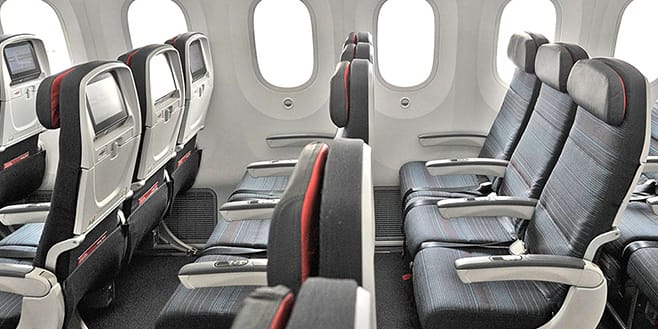
Some aircraft have just economy class and nothing else, especially with ultra low-cost carriers (but often with low-cost carriers too). It’s called a single-cabin configuration or layout.
It’s the section at the back, with the tightest seats and the fewest inclusions. As mentioned, it varies a bit from one airline to another and from one aircraft to another with the same airline… but not that much.
Almost all of my 500+ lifetime flights have been in economy class, and it’s clearly the best option for saving money or traveling more. It’s really not that bad, especially for daytime flights.
You can read our pro tip to at least greatly increase your chances of having a whole row if you travel as a pair, or an empty seat next to you if you travel solo. That improves the economy class experience.
Economy class is almost always called economy class, but some airlines find a way to change the name of this one, too (like American Airlines, which calls it “Main Cabin”).
The only thing to note is that some economy class seats are a bit better than others in the same plane.
It’s still considered the same class, but sometimes seats have a bit more legroom (like the first row at the front or emergency exit rows). That’s the only exception.
Almost all planes have economy class. Not all, but all-premium configured aircraft are very very rare.
I took one on Air Canada, as I had shared. But that’s special; they sell the seats as economy class seats (because there are no special services or inclusions).
Other airlines have specific planes with no economy seats that are used for long flights, like Singapore Airlines for the world’s longest flight (New York-Singapore). Some that are more unique are the French airline La Compagnie and the Maldivian airline BeOnd, which have no economy seats.
Premium economy class — Airplane seat classes
This is the newest of the 4, so maybe you’re not familiar with premium economy class.
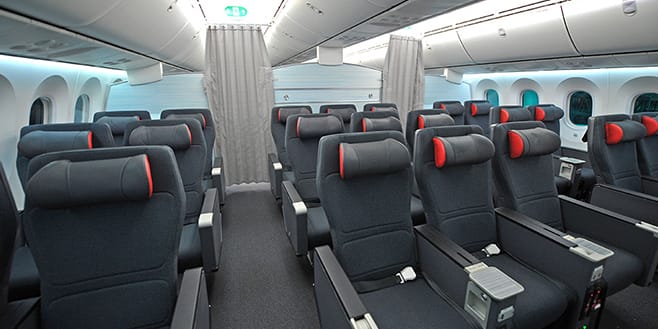
There were only the other 3 classes for a long time. But in recent decades, as business class became incredibly more luxurious and economy class became incredibly worse, a middle option emerged.
Airlines started offering premium economy class for those who don’t want to be in economy class but haven’t yet understood the usefulness of airline points for traveling in business class.
It’s very often offered on widebody aircraft, but rarely on narrowbody aircraft.
This class varies quite a bit. Sometimes they’re the same seats as economy class with simply more legroom. But often, the seats are better.
Often, there are additional inclusions like priority boarding, food (or better food), amenity kits, etc.
Personally, I’ve never found that the price difference between economy class and premium economy class was worth it. For much less money, you can easily travel in business class with airline points.
That said, I’m sure the experience is at least better than economy class. It’s up to you to decide if you think it’s worth it.
Most airlines call it premium economy, but some change things up a bit (like “Premium Plus” on United or “Premium Select” on Delta). It’s the same thing.
As mentioned, this is not to be confused with preferred seats or others that are better economy class seats without being a separate class.
Business class — Airplane seat classes
This is what everyone can easily achieve: the extremely luxurious business class that will change how you see the flying experience.
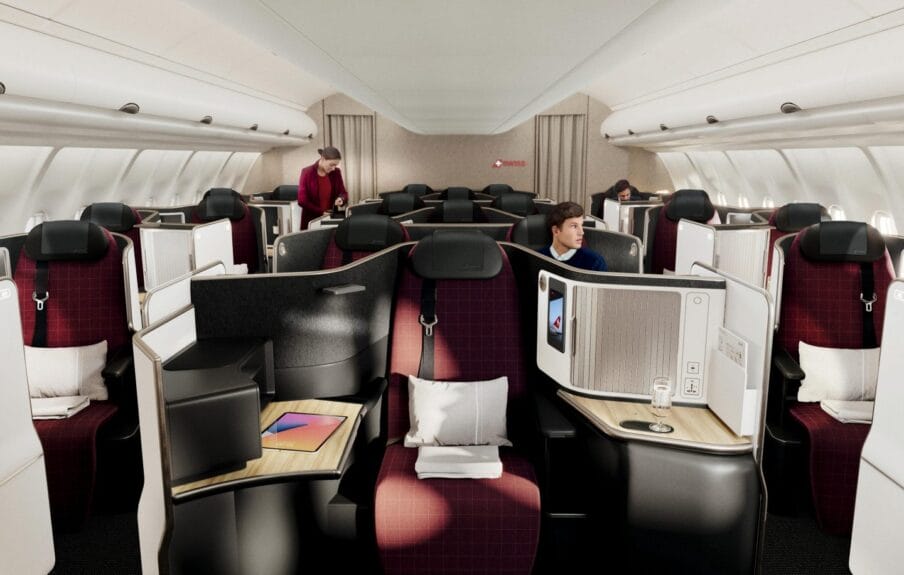
It’s the most common of the 2 truly luxurious options because the vast majority of airlines and aircraft don’t have first class.
It’s also the most common of the premium cabins because many narrowbody aircraft only have 2 seat classes, and the one at the front is called business class even though it usually has nothing to do with the luxury of “real” business class on widebody aircraft.
Business class varies enormously from one airline to another. Generally, good business classes have a lie-flat pod seat at a minimum. Some have closed doors for even more privacy. But sometimes the seats are old and not so interesting.
The service level is obviously much higher, too. On my Qatar Airways flight, the champagne was worth 429.99 USD per bottle, the meals were delicious and unlimited, the flight attendant made my bed for me, the amenity kit was from luxury brand Diptyque, etc.
It’s quite wonderful to travel in ultimate luxury like that. And to sleep well. Especially for overnight flights or very long flights.
On smaller planes, it’s much less interesting. And I don’t feel it’s worth the extra points at all; I’d recommend keeping them to get long flights in business class more often. The seat is usually wider (or with a blocked middle seat) and there’s more space, but it’s not the same seat experience at all. The services are usually good, at least, though.
I haven’t traveled in business class that often, but I’ll do it more since I travel a bit less and therefore have plenty of points to do it. Especially with the million points I just got with the most phenomenal promo of the decade (that’s 6 roundtrip business class flights from Canada to Southeast Asia).
Airlines love to give a unique name to their business class, whether it’s Air Canada Signature Class, Qatar Airways Qsuite, United Polaris, Delta One, etc. That at least has the utility of usually clearly differentiating which aircraft have the “real” business class (but never assume; always check).
First class — Airplane seat classes
The most luxurious way to travel, some find it almost exaggerated to fly in first class given how over the top it is.
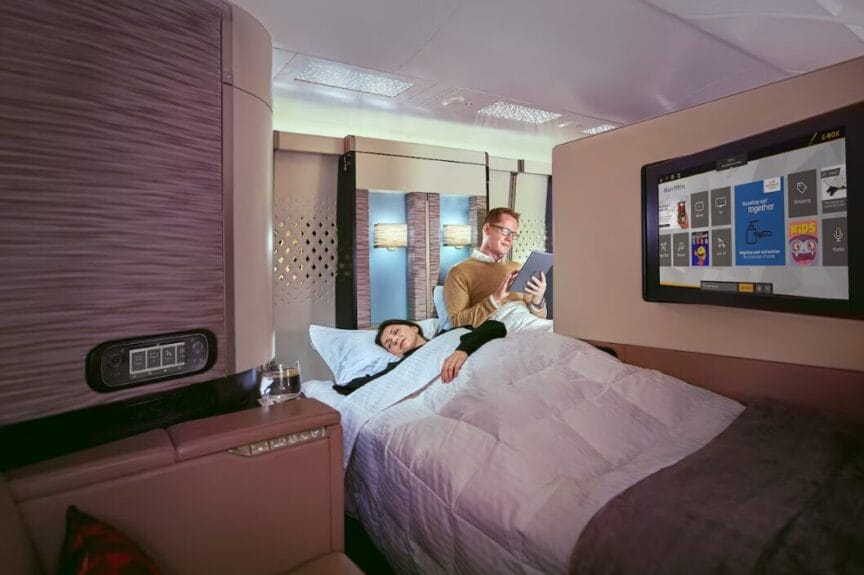
Only a few dozen airlines in the world have first class in addition to business class. It’s even more luxurious, obviously.
The best example is The Residence by Etihad. The first class “seat” is actually 3 separate rooms: a bedroom, a living room, and a shower room.
That’s what I mean by almost exaggerated. But if for you the lie-flat pod seat in business class isn’t enough, obviously you can also get first class at a fraction of the price thanks to airline points.
I personally find that it’s not worth the difference in points compared to the already excellent business class lie-flat pod seats, so I’ve never tried it and I’m not particulary attracted to it (again; I like to travel more often).
But I’m not much of a luxury traveler, and maybe you’re attracted to that!
Learning how to travel for less
Join over 100,000 savvy Canadian travelers who already receive Flytrippers’ free newsletter so we can help you travel for less!



